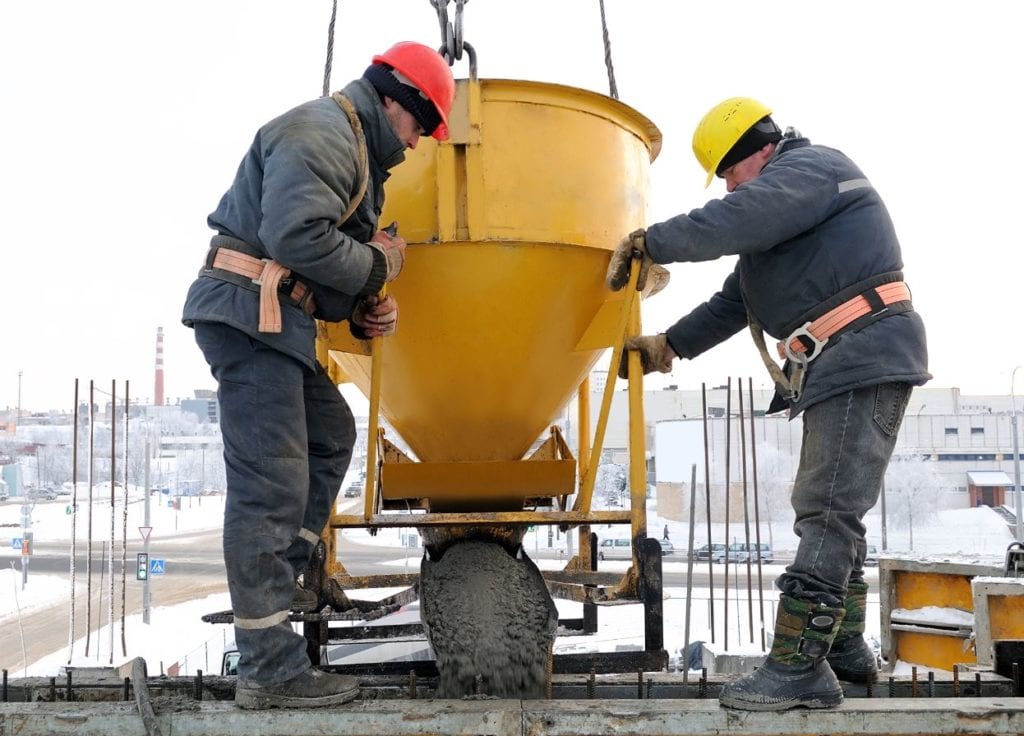
The strength of concrete largely depends on the temperature at which it cures, and since the ideal curing temperature is around 70 degrees, pouring concrete foundations in cold weather takes extra preparation.
Concrete changes from a liquid to a solid through a chemical reaction, and the speed of the reaction depends on temperature. After placing, cold temperatures (considered to be below 40 degrees for three consecutive days) often increase cure time for concrete. It must be protected from freezing until it has reached a minimum strength of 500 pounds per square inch (psi). It’s also worth noting that any ice formation can result in 50 percent reduction in strength. This happens because when water freezes, it expands and can cause concrete to crack.
Site prep: Pouring concrete foundations in cold weather
The ground must be thawed before placing concrete, with the subgrade near the same temperature as the concrete being poured. Here are some important details to address:
- Thawing methods: A few options involve using hot sand/gravel, steam or heaters.
- Heaters: If you’re using these, check their performance and ensure they have enough fuel or power access for the entire curing process. NOTE: Crew members shouldn’t be overexposed to certain heaters due to the potential presence of carbon monoxide.
- Insulation: The work area can be insulated with straw cover that’s held in place with wood, tarps or plastic sheeting.
- Surrounding enclosures: Waterproof windbreaks and foam sheeting help protect curing concrete from wind, drops in temperature and excessive evaporation. Make sure you have a way of holding them in place during windy conditions.
- Forms: Keep forms in place as long as possible because they help distribute heat more evenly. Removing formwork when concrete is too cold could compromise concrete strength. Additionally, reinforced steel and post holes should be free of ice, snow and frost.
- Concrete mixture: It might be necessary to adjust a mixture according to the ambient temperature. This might involve an increase in cement content, the use of an accelerating chemical admixture or both.
- Curing blanket: These easy-to-install devices can be used to thaw ground before pouring and again after finishing, helping to keep concrete from freezing or cracking. Typically, a blanket can be removed after three days to let the concrete air dry. However, be sure to prevent rapid cooling after the heating period. This can result in thermal cracking.
More curing details to note
Keep concrete in a warm area prior to mixing. It’s also important to control the amount of air entrapped in concrete during cold-weather pours.
It’s largely up to the concrete supplier to ensure the mix size, cement proportion, admixtures, sand gradation, mix water temperature and mix time. Batch plants can also add accelerators, such as calcium chloride water solution, to speed up the curing process.
It sometimes makes sense to request extra cement for each cubic yard of concrete, which helps develop more strength early on. Once the concrete fully solidifies, avoid using de-icing salts, which can corrode the surface and spread water, leading to freezing and cracking.
Ultimately, in cold weather, it’s recommended that concrete has a minimal water-to-cement ratio, which helps reduce water bleeding toward the top and slowing down setting time. Utilize squeegees or a vacuum to remove any bleed water that struggles to evaporate during cold weather and try to maintain a consistent water temperature in each batch of concrete.
Related posts
Job site winter storm preparation | Severe weather emergency action plan
Best winter work gear guide for extremely cold job sites (FREE DOWNLOAD)